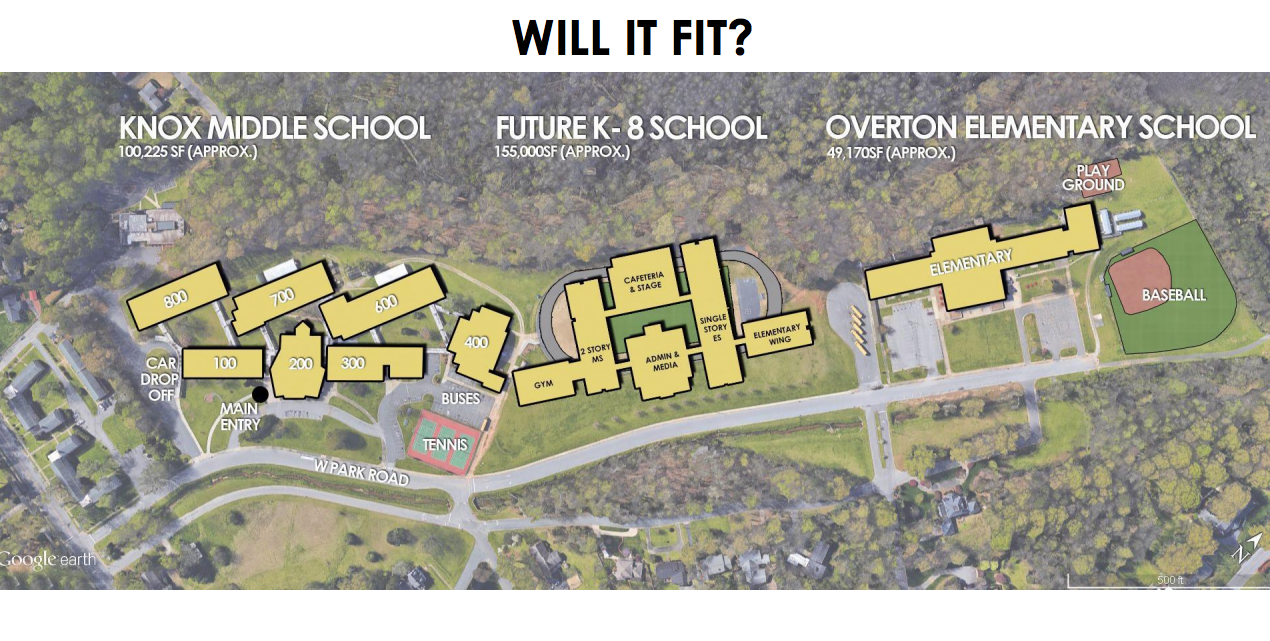Ballooned price tag for Knox-Overton K-8 project raises questions about how to proceed
Published 9:54 pm Monday, February 7, 2022

- A 2020 overlay showing how a K-8 between Knox and Overton could sit between the two facilities, which would later be demolished.
SALISBURY — The Rowan-Salisbury Schools Board of Education faces uncertainty over the cost of a combined elementary and middle school project in Salisbury.
The Kn0x-Overton K-8 project is few years in the making. Previously agreed upon by the school board, the pandemic put a halt to new capital projects funded by county government. Work picked up again in 2021 after funds for the project were unfrozen by the Rowan County Board of Commissioners.
But construction material costs have been in flux since the beginning of the COVID-19 pandemic, peaking in mid 2021. On Monday, the project’s contractor talked to the school board about material cost increases raising the estimate for the K-8 from $55 million to $69.6 million — more than $14 million more than the original price tag.
Barnhill Contracting’s Chad Webb showed the board a report of Federal Recovery Economic Data. He described the information as a “crystal ball” for contractors to take a look at market conditions.
Increases are the reality for the world at the moment, Webb said. He noted significant price increases on concrete, steel beams, joists and decking. Webb said 25-30% increases in costs due to material prices are present across the industry. Project architect David Bellamy said there are some new steel plants being built and market capacity building that give some hope on material cost.
“We’re in the early stage of the design program,” Webb said.
There are more phases of design and construction documents to assess pricing. Webb said during each phase the company will provide updated cost estimates and value options.
One consideration is whether to demolish the Overton Elementary School building. The original plan for the project was to demolish both Knox and Overton, with the two being combined on the new facility built in the space between the two schools. By not demolishing Overton, design and engineering complications could increase the cost of the project by $1 million.
Board member Kevin Jones questioned whether the board has done a good enough job speaking to the community about what it needs. Jones asked the school board to think on that level rather than solely cost reductions.
Board Chair Dean Hunter asked for a list of pros and cons to be created so the board can make a final decision during its Feb. 28 meeting.
Board member Brian Hightower said the district needs to make sure it can come up with the money for the project because the community deserves it.
“If you’re going to do something, let’s do it right,” Hightower said.
Hightower said the district needs to figure out a way to get the nearly $15 million.
Vann said there are other possibilities to put the project in reach without securing more local funding, including market stabilization and grant money from the state.
The Needs-Based Public School Capital Fund is a program that awards districts with funding for major capital projects. The district has a shot at netting $40 million for the K-8 through the program. Historically getting grant funding through the program has stopped districts from receiving North Carolina Education Lottery funding for a few years, but that’s no longer the case. Bellamy said this was confirmed by the N.C. Department of Public Instruction.
Vann noted the program seems to favor “shovel ready” jobs — ones approaching the start of construction.
The board will move ahead on an application for the state funding, which is due by March 15. School board Chair Dean Hunter and County Commissioners Chair Greg Edds both have to sign off approving the submission of the application. The board would have to match 15% of the funds it receives, but RSS would easily cover the match with the amount money the district will put into the project.





